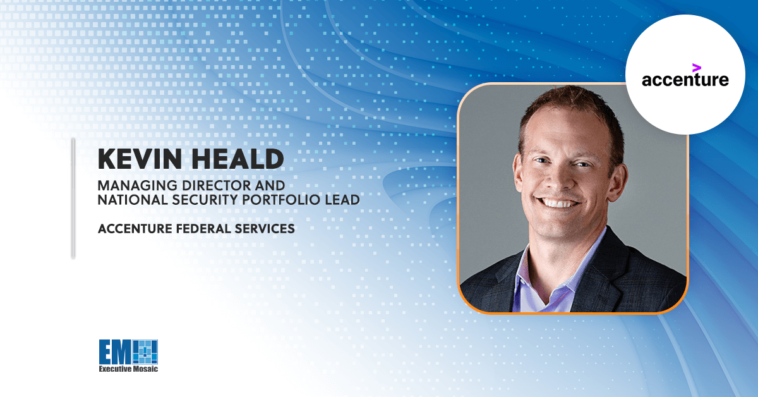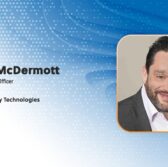Artificial intelligence and cloud technologies are advancing faster than ever, opening up exciting new opportunities for innovation. In this Executive Spotlight interview, we spoke with Kevin Heald, managing director of Accenture Federal Services’ National Security portfolio, to learn more about how AI, cloud and other emerging technologies are shaping the cyber landscape and the GovCon ecosystem.
Read below for the full interview.
Tell me about the current state of the artificial intelligence market. Where are you seeing new opportunities in AI, and where do you think the market is heading?
AI and machine learning have been around for a long time now. I think what has changed with GenAI is how much easier it is to use AI tools across our mission customers’ requirements. Our teams have been experimenting with tools in the machine learning space for years now, but really the last year has seen a huge shift with ChatGPT and other models that are out there. One of the things that we’ve seen is there are so many different solutions right now. How do you navigate which solutions apply for which challenges? There are literally hundreds of startups in this space, so how does the federal government use those capabilities in an effective way?
We are working with our customers to help navigate that hype cycle. We’ve seen this in other technology shifts where there’s a lot of promises being made, but how do those promises actually get met? Then, once we’ve narrowed down what models are potentially useful for our clients, how do we figure out which of their use cases applies for which model? Accenture Federal Services has a ‘switchboard application’ that allows us to decide which model is applicable to which use case. We don’t have to necessarily pick a model. Instead, it’s a marketplace for models, depending on what’s going on there. We’re already doing GenAI for several of our clients in use cases like search, synthesize, call center work, document code creation and things of that nature.
We’re also doing some of that same work for ourselves. For our federal clients, there are hurdles that we have to go over from a security perspective to determine what our customers can actually use with both CUI (controlled unclassified information) as well as classified information. We are already seeing how gen AI can help enable it further from there.
Let’s talk about cloud. What are some of the key barriers that remain in widespread federal cloud migration, and how do you think we can overcome them?
First and foremost, cloud service providers continue to release amazing capability, but often those capabilities don’t have parity with what’s available to our federal customers, whether that be FedRAMP or disconnected sovereign clouds. There’s sometimes a lag in those capabilities being available for our customers. Part of this is just navigating that parity so that our customers know which resources are available to them.
We have seen a big push from all of our federal customers — to include national security customers — where we can develop low and push to high. So, we can work in an unclassified way that is not sensitive, and then push up to the high side. We make sure we develop those applications emulating what is going to be available in the production environment. Then when we migrate those other environments, we minimize any application issues.
From a migration perspective, we have been applying our Cloud Migration and Modernization Factory. Recently, we announced a partnership with Microsoft on this, where we are working with CIOs and other government customers on which applications should be modernized and when. This is not just migrating from what would be in a data center to the cloud. This could also be modernizing what we may have “lifted and shifted” to the cloud in order to make better use of the capability that’s available. The promise of cloud from the very beginning was that it was a cost savings option. There are plenty of places where that is true, but there are also places where because workloads have been lifted and shifted as-is, there is limited savings.
We’ve also been leaning very hard into our Cloud FinOps (financial operations) approach for our government customers. This includes a tool called CloudTracker, our cloud-agnostic offering for single-pane visibility and oversight of enterprise cloud performance and activity. When combined with FinOps certified approaches, our customers can better understand their cloud utilization to react and engage with application owners in real time on how they can modernize their application to save money. The goal is to save those dollars that can be applied to mission for our defense and other customers.
And lastly, sometimes it is easy to forget that there is a defense industrial base (DIB) that must work in a secure environment. The federal government is applying the same standards that apply for government environments. We are seeing increased demand from companies coming to Accenture Federal Services to apply the same tools and methodologies we do for our government customers to develop in a secure way.
Kevin, from your vantage point as Accenture Federal’s national security portfolio lead, what are the most pressing national security trends/shifts you are seeing? How is your organization addressing these trends/shifts?
We can’t support the mission without being secure, so cybersecurity will always be a focus. What we’ve seen recently is how we apply cybersecurity in a more efficient and automated way. We’ve done that in a couple of different places, including in the consistent application of zero trust architectures. We have several partnerships, including with Palo Alto and Google, and we’re working with them and leveraging those ecosystem partners to better enable cybersecurity for our customers. We’ve already discussed the amazing possibilities of GenAI, and our customers are excited about applying in a secure, responsible way. It feels similar to where we were with cloud eight to ten years ago. Cloud was becoming the hot thing – enabling our engineers and developers to rapidly solve our customer mission challenges.
But as we talked about before, how does Accenture Federal Services, and more importantly our customers, navigate this? How do we help our customers navigate which solutions are the most cost effective? There’s only so many GPUs, only so many high-end computers you can use. How do we do this effectively so the customer knows when they really have to develop their own model or when they can tailor and customize a model? We recently hired Denise Zheng, who came from Accenture global, to be the Accenture Federal Chief Artificial Intelligence Officer. I am super excited to see how we can apply what has been done commercially worldwide for our federal customers. There is amazing innovation that’s happening throughout the world that we can learn from to enable fit-for-federal solutions for our government customers.
We can’t do what we do without recruiting and retaining our amazing people. Our space has a limited pool of candidates, whether that be clearance, citizenship requirements, or work location requirements. That’s not just for us in industry, this also applies for our government customers. It is hard to recruit and retain talent.
And then the last thing is, given what we see going on in the world right now, international collaboration is more important than ever. I’m a firm believer that the United States is where we are because of international collaboration. We need to continue to lean on that. One of the more recent initiatives that has come out is called AUKUS, which is the Australian, U.K., U.S. trilateral security partnership for technology development and global security. We have had several different work sessions, both internally in Accenture Federal Services and then within the wider Accenture organization — which includes folks from the U.K. and Australia — about how we can support that partnership, to make sure the world is safe.
Where are you seeing opportunities for expansion in Accenture Federal Service’s National Security portfolio? What new capabilities or markets are you eyeing?
Certainly generative AI, as we’ve discussed. Generally, in the defense and intel space, we see a lot of new work coming. I mentioned some of the defense industrial base work, we’ve talked about CJADC2 (Combined Joint All Domain Command & Control), which is another place that you’ll see us continue to push into. We’re starting to see more use of software-as-a-service offerings, for example Human Resources and ERP, for federal and national security customers. How do we take what the rest of the world is using from an HR system perspective and apply that for our defense and Intel customers?
Our recent acquisition of Cognosante is really a continued investment by us in the federal health market generally. We’re super excited that’s going to empower our solutions for health customers.
And finally, we see opportunities within the global security mission. Things are getting more and more unsure every day, so how do we make sure the nation and the world are safe moving forward? There’s a lot of opportunity, and we share responsibility to make sure that it’s done right.





